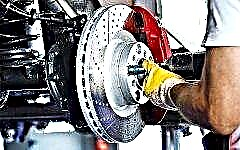

The content of the article:
- Lerdal tunnel
- Track in Everett
- Highways of Germany
- Bypass road in Sochi
- Gotthard autotunnel
- Ring road in St. Petersburg
- Changje - Jishou track
- Boston freeway
- Highway Adler - Krasnaya Polyana
- Moscow Ring Road
Competent operation and allocation of sufficient funds for the maintenance of road infrastructure ensures continuous and, most importantly, safe movement of cars and pedestrians.
A road is not only a roadway, but also lighting, barriers, traffic lights, engineering communications and other elements that require capital investment.
About the most expensive tracks in the world - in our review
10. Lerdal Tunnel (Norway) - $ 7 million / km

The Norwegian road tunnel has become the longest in the world, connecting several municipalities as well as the capital with Bergen.
The 24.5 km long structure cuts through 1,600-meter mountains, making drivers jittery about the multi-ton boulders overhead. Therefore, the tunnel along its entire length was equipped with a unique illumination that continuously changes colors, thus relieving motorists of the feeling of anxiety in a confined space.
Additionally, the tunnel has artificial grottoes that carry the functionality of a recreation area, where drivers can take a break from the monotonous movement. Good ventilation is provided by several special installations, which at the same time purify the air.
As a security measure, fire extinguishers are fixed every 125 meters, and telephones for communication with emergency services can be seen every 250 meters.
The construction of the grandiose structure took 5 years and required an investment of 113 million euros
9. The track in the city of Everett (USA) - 8.85 million dollars / km

American highways serve as role models for many countries, while being fast and safe at the same time.
In ninth place in our ranking is the three-lane 27-kilometer circuit in Washington state, which is also one of the longest and widest roads in the world. Its task is to unite a number of remote areas, industrial and agricultural, ensuring uninterrupted passenger and cargo transportation.
However, large-scale construction required considerable investments - each kilometer cost taxpayers almost $ 9 million.
8. Highways in Germany - $ 20 million / km

Almost all German highways, regardless of their direction, load, landscape, have a high-quality surface and high performance characteristics.
In Europe, road construction is approached very seriously and comprehensively, observing technological and environmental standards.
For example, on one of the German streets, they noticed road noise, and therefore, over 2.5 km of the road, the builders removed the top layer and replaced it with a 7-centimeter noise-absorbing coating.
The state does not spare funds to maintain the road infrastructure at the proper level, so each construction costs fabulous money. But all German roads not only meet all conceivable standards, but also save German drivers from congestion.
7. Bypass road in Sochi (Russia) - $ 26-30 million / km

The project of this road was born back in 1988. Slow construction was frozen, only to resume in 1998. Therefore, the first 4.5-kilometer section of the road was opened for operation only in 2001, and the next, 4.27-kilometer, in 2008.
The highway passing through the Khostinsky and Lazarevsky districts allows drivers to save a considerable amount of time without pushing through the center of Sochi. The third section was commissioned in 2009, extending the road to 18 km, but further construction is in the plans of the designers.
6. Gotthard Autotunnel (Switzerland) - $ 54.2 million / km

One of the longest in the world, this tunnel has become the most expensive construction in its country. Its high cost is justified by the fact that the engineers had to fight with the difficult terrain and rock formations of the Lepontine Alps.
Granite is a very durable stone, which required special and extremely expensive equipment to work with.
Since the tunnel has only one side in each direction, the speed is limited to 80 km / h in order to maintain traffic safety.
5.KAD in St. Petersburg (Russia) - 55.24 million dollars / km

The St. Petersburg Ring Road occupies a "bronze" pedestal in the rating of the most expensive Russian roads. Its 142 kilometers wrap around the city and connect all the key highways. Global construction was funded by the federal budget and was frozen more than once due to lack of funding.
The width of the route is from 4 to 8 lanes, there is not a single traffic light along its entire length, and the permissible speed of 110 km / h and 26 interchanges allow you to quickly and safely cover long distances.
The construction price of each site varied depending on the specific relief.
4. Highway Changje - Jishou (China) - 71 million dollars / km

In the photo: The Changje - Jishou route is actually a crossing over a huge gorge.
The Chinese authorities consider the automotive infrastructure to be an important element for strengthening statehood. Therefore, much attention is paid to the construction, reconstruction and subsequent operation of the routes.
The Chinese terrain is so diverse that it costs the treasury a lot of money to build each road, ranging from $ 1.99 million per kilometer to $ 71.16 million for the Changje-Jishou highway.
The uniqueness of this amazing route, which connects two trading cities, lies in the fact that most of it runs over a huge gorge. This miracle of Chinese engineering is a complex structure of columns fixed on vertical sections that hold a beautiful road bridge.
Jishou and Changje are of great importance to the Chinese economy, and therefore fast communication between them was strategically necessary. Therefore, even if the construction required colossal investments, this path has become not only an important event in the life of the country, but also a local attraction.
3. Boston Highway (USA) - $ 117.5 million / km

The capital of Massachusetts, Boston is one of the richest and most densely populated cities in America. Measures were required to unload the central roads, but the development did not allow them to be expanded or to arrange interchanges or overpasses.
Therefore, it took fantastic funds to overhaul the entire city center to build bridges, tunnels and new highways.
The Great Boston Tunnel, which has become the most expensive project in American history, during the construction of which 150 cranes removed tons of soil every day, received 8 traffic lanes, significantly improved the ecological situation in the city, became the main transport artery and did not damage a single building.
2. Highway Adler - Krasnaya Polyana (Russia) - $ 140 million / km

Paradoxically, despite the fact that Russian highways have repeatedly been included in the rating of countries with the worst roads, considerable sums are allocated for their construction and maintenance.
Commissioned in 2013, the track, laid across the Adler District, was designed for the Olympic competitions and prompt delivery of participants to sports facilities.
The construction of 48 kilometers required 227 billion rubles, which is due to the difficult mountainous terrain, the proximity of the Mzymta River and the seismic instability of the region.
1. Moscow ring road (Russia) - $ 578 million / km

Motorists explain the fantastic high cost of Russian roads by corruption and money laundering, since not every road in terms of quality and functionality justifies the investment.
The Moscow Ring Road has become the leader of the rating by a huge margin from other competitors, and it might not have existed on the road map of the capital.
In the process of laying the 4th transport ring, it became clear that the construction required too large investments. Then officials and engineers decided to reconstruct some of the interchanges, and then combine them into a ring. This is how the idea of the Moscow Ring Road was born - a structure, the construction of which started in 1956, and after 6 years the road was put into operation.
In 1995-1998, the track underwent a global reconstruction. The next one was planned for 2011 with the restructuring of interchanges, the construction of new transport hubs, and the laying of backup roads. But the plans came true only partially due to the underfunding of the project.
The Moscow Ring Road never crosses other highways at any of its levels, and also has 5 lanes, which increases the throughput of the road.
Conclusion
It is important not only to lay new roads, tunnels, bridges and junctions, but also to maintain them further and maintain them in proper operational condition. From year to year, the traffic intensity is increasing, the roads are experiencing huge congestion, and therefore require constant maintenance and monitoring of the technical condition. And the safer, more modern and more perfect in the engineering and technical sense these roads are, the more impressive investments they need.











